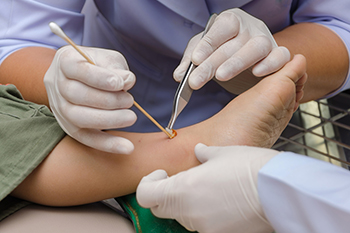
Chronic wounds on the legs and feet require a combination of specialized care and ongoing management. One important step is debridement, the careful removal of dead or damaged tissue to encourage new growth. Dressings tailored to the type of wound help maintain a healthy environment, whether by keeping moisture in or absorbing excess fluid. Infection control is another priority, often involving topical or oral antibiotics when needed. Improving circulation plays a central role, particularly for wounds linked to arterial or venous problems. This may include compression therapy for venous ulcers or procedures to restore blood flow in cases of arterial disease. Offloading pressure with custom footwear or padding helps prevent further damage, especially in diabetic ulcers. Advanced options such as growth factors, cellular tissue products, or negative pressure wound therapy may also be recommended. Because treatment must match the wound’s cause, it is suggested that you see a wound care specialist for a personalized plan.
Chronic Wounds and Complications That Slow Recovery
Most wounds follow a predictable healing pattern, but some linger far longer than expected. Chronic wounds are those that fail to progress through normal healing, often remaining open, painful, and vulnerable to infection. On the feet, ankles, and legs, these stubborn wounds can significantly limit mobility and quality of life.
Post-surgical wounds are a common source of concern. While surgery is intended to improve health, the incision site does not always close as planned. Compromised circulation, infection, or pressure can delay healing and leave patients dealing with ongoing discomfort. Professional monitoring and care are essential to ensure the wound is cleaned, dressed, and supported until closure is achieved.
Chronic pain conditions may also complicate recovery. Neuromas, for example, are thickened nerve tissues that can cause persistent pain in the foot. Although not open wounds themselves, they often interfere with normal gait and create pressure points that make the skin more prone to breakdown. Left unaddressed, this discomfort can contribute to recurring sores or prevent existing wounds from closing.
Chronic wounds require specialized attention because traditional home remedies are rarely enough. Advanced wound care techniques may involve debridement, specialized dressings, pressure offloading, or therapies designed to improve blood flow and tissue repair.
If you have a wound on your foot, ankle, or leg that is not healing or continues to reopen, call us today for expert care from our wound specialist.
